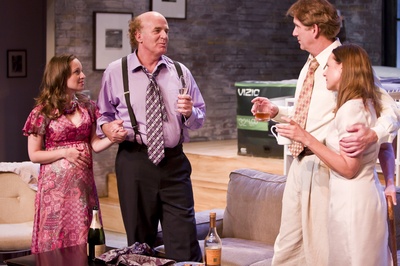Moving 'Time Stands Still' at Performance Network explores the difficulties of long-term love

From left, Heidi Bennett, Hugh Maguire, John Lepard and Suzi Regan in "Time Stands Still."
photo by Sean Carter | courtesy of Performance Network
And while this lifelong capacity for change can be exhilarating, it can also be—for those aiming to have a partner for life—terrifying, as it is for the two main characters in David Margulies’ “Time Stands Still,” now playing at Performance Network.
James (John Lepard), a globetrotting journalist, and Sarah (Suzi Regan), a driven, successful photojournalist who’s expert at chronicling the horrors of war around the world, come home to their Brooklyn loft at the play’s outset. Sarah is badly hurt, having narrowly escaped death (via roadside bomb) in Iraq; and James is getting over a breakdown that was the cause of his coming home early, thereby leaving Sarah behind.
Sarah’s editor (and former lover) Richard (Hugh Maguire) enters the scene with his balloon-toting, young, event-planner girlfriend Mandy (Heidi Bennett) in tow. James and Sarah immediately mock Richard for his seeming midlife crisis, but he and Mandy are genuinely happy and in love—a fact that causes James and Sarah to assess the nature of their own relationship.
Along the way, the tricky morality of photojournalism is touched on, by way of Sarah’s experience with a flashback, and Mandy’s response to Sarah’s most recent photos; plus, Margulies raises the question of precisely what, if anything, is achieved when articles about world crises appear in the pages of American magazines: Does it help bring about substantive change? Or does it simply feed liberal guilt and make people say, “Oh, that’s terrible” before turning the page?
Compelling, debatable topics, to be sure—but a couple of the script’s bumpiest moments arise in service to them, making them seem a bit “tacked on” at times. For instance, after Mandy sees a photo Sarah has taken of a mother grieving over her dying child, she gets agitated and associatively launches into a description of a documentary she watched about a mother and baby elephant who lose each other in a sandstorm; the amped-up moment feels clunky and self-conscious. Also, Margulies rides the line of making Mandy too much of a “dumb girl” cliche when he has her doing things like making a note for herself to see the film “Brazil”—which James references, and she’s never heard of—as if she’s studying to be Richard’s mate.
But Margulies is on much firmer, more fertile ground when focusing on complicated changes happening within Sarah and James’ relationship, and how they both deny and adapt to them.
Regan and Lepard are a dream team duo. Regan makes Sarah’s constant need to keep moving and put herself in harm’s way a vulnerable, sympathetic quality that hints at a painful past—one she’ll likely never fully come to terms with; and Regan’s subtle work in a moment near the play’s end, when she looks into the face of Mandy’s baby, is heartwrenchingly powerful. Lepard, meanwhile, deftly paints a portrait of a man who, after a dark night of the soul, is in the midst of a significant change that he knows will threaten the balance.
As a counterweight couple, Maguire and Bennett also provide strong performances. Maguire imbues Richard—a useful barometer of Sarah’s professional success and James’ professional struggles—with an openness and a dry wit. And despite the fact that Margulies introduces Mandy in an overblown fashion, Bennett manages to win the audience over with her candor and, in her own way, common-sense smarts.
Director Kate Peckham oversees this well-paced, engaging production, using Sarah Tanner’s set, decked out with Charles Sutherland’s props, to best advantage. Mary Cole’s lighting design nicely underscores each scene’s tone, while Mary Copenhagen’s costume design—note how Mandy’s red outfit seems to shout among the muted colors that the other characters wear—conveys each character’s personality. Finally, Phil Powers’ sound design evokes the wider, more chaotic world that consistently seduces Sarah like a Siren’s song.
So although Margulies’ script glosses over some of the very themes it aims to grapple with, the true heart of “Time Stands Still”—that is, the inherent challenges of longterm love—pulses with vigorous life.
"Time Stands Still" continues through Oct. 23. Tickets: 734-663-0681 or the Performance Network website.


Comments
Ruth
Sun, Oct 2, 2011 : 3:13 a.m.
I think the point of Mandy's tearful description of the baby elephant separated and lost from her mother in a sandstorm was that a photojournalist was standing right there, filming what was happening. Why didn't the photographer intervene, Mandy asks, and help the baby find its mother. Why did he just stand there taking pictures. Her question points out the dilemma of whether a photojournalist records what is happening, or intervenes to try to change the situation. Which action has more impact?
Jenn McKee
Sun, Oct 2, 2011 : 4:38 p.m.
I absolutely understood that that was the connection being made. My point was that the conversation seemed to escalate and progress in an unnatural way. No matter how guileless Mandy is, she'd JUST met Sarah, and leaping into a highly emotional debate, and having this example at the ready, didn't feel realistic to me. Maybe if the conversation had built up more gradually, I would have believed it in context.